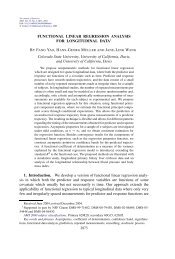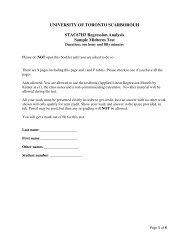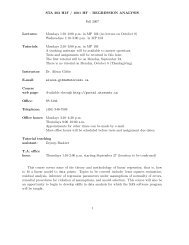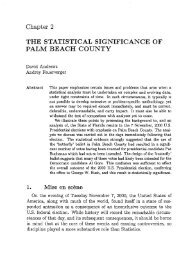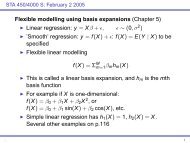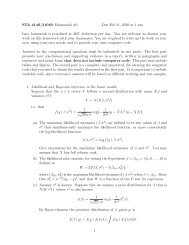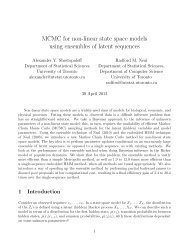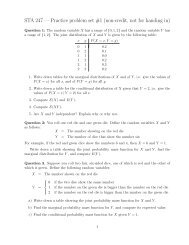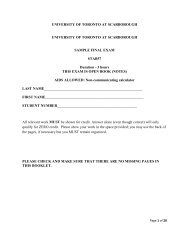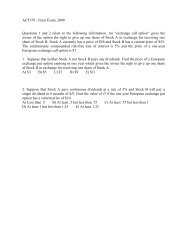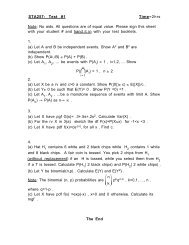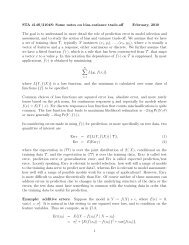CREDIBILITY - PROBLEM SET 7
CREDIBILITY - PROBLEM SET 7
CREDIBILITY - PROBLEM SET 7
- No tags were found...
Create successful ePaper yourself
Turn your PDF publications into a flip-book with our unique Google optimized e-Paper software.
<strong>CREDIBILITY</strong> - <strong>PROBLEM</strong> <strong>SET</strong> 7Empirical Bayes Credibility MethodsProblems 1 to 3 refer to the following situation. An insurance company has two group policies.The aggregate claim amounts (in millions of dollars) for the first three policy years aresummarized in the table below. Assume that the two groups have the same number of insureds.Aggregate Claim AmountsGroupPolicy YearPolicy " # $"5 8 11# " 1 " 3 " 21. Find the Buhlmann credibility premium for group 1 for the fourth year.A) 8.0 B) 8.2 C) 8.4 D) 8.6 E) 8.82. Using the credibility-weighted average estimate of . (also referred to as the method thatpreserves total losses), find the Buhlmann credibility premium for group 1 for the fourth year.A) 8.0 B) 8.2 C) 8.4 D) 8.6 E) 8.83. Suppose that the aggregate claim amounts for group 2 for policy years 1, 2 and 3 are2 , 8 and 14 (instead of 11, 13 and 12). Find the estimated Buhlmann credibility premium forgroup 1 for the fourth year.A) 8.0 B) 8.2 C) 8.4 D) 8.6 E) 8.8Problems 4 and 5 refer to the data of Example CR-34 in the notes, with the followingmodification. Assume that there is a third group with the following experience for the threeyears:Policy Year1 2 3Aggregate Claim 10,000 15,000 13,500Size of Group 50 60 604. Find the credibility premium per exposure unit for policyholder 1 for the fourth year(nearest 1).A) 203 B) 205 C) 207 D) 209 E) 2115. Using the credibility-weighted average estimate of , find the Buhlmann credibility premium.per unit of exposure for group 1 for the fourth year (nearest 1).A) 203 B) 205 C) 207 D) 209 E) 211
Problems 6 and 7 refer to the data of Example CR-34 in the notes, with the followingmodification. For group 1, assume that there is no data for the first policy year (but all threeyears of data are still available for group 2).6. Find the credibility premium per exposure unit for policyholder 1 for the fourth year(nearest 1).A) 206 B) 208 C) 210 D) 212 E) 2147. Using the credibility-weighted average estimate of ., find the Buhlmann credibility premiumper unit of exposure for group 1 for the fourth year (nearest 1).A) 206 B) 208 C) 210 D) 212 E) 2148. For a large sample of insureds, the observed relative frequency of claims during anobservation period is as follows:Number Relative Frequencyof Claimsof Claims0 61.9%1 28.4%2 7.8%3 1.6%4 .3%5 or more 0Assume that for a randomly chosen insured, the underlying conditional distribution of number ofclaims per period given the parameter @ is Poisson with parameter @.Given an individual who had - claims in the observation period, use semiparametric empiricalBayesian estimation to find expected number claims that the individual will have in the nextperiod.A) Þ*$- Þ%'& B) Þ*$- Þ&!! C) Þ!(- Þ%'& D) Þ!(- Þ&!! E) Þ*$- Þ!$&9. You are given the following:- The number of losses arising from 500 individual insureds over a single period of observation isdistributed as follows:Number of Losses Number of Insureds0 4501 302 103 54 55 or more 0- The number of losses for each insured follows a Poisson distribution, but the mean of eachdistribution may be different for individual insureds.Determine the Buhlmann credibility of the experience of an individual insured over a singleperiod.
13. (SOA) The number of claims a driver has during the year is assumed to be Poissondistributed with an unknown mean that varies by driver. The experience for 100 drivers is asfollows:Number of Claims during the Year Number of Drivers0 541 332 103 24 1Determine the credibility of one year’s experience for a single driver using semiparametricempirical Bayes estimation.(A) 0.046 (B) 0.055 (C) 0.061 (D) 0.068 (E) 0.07314. (SOA) The following information comes from a study of robberies of convenience storesover the course of a year:>2(i) \ 3 is the number of robberies of the 3 store, with 3 = 1, 2, á, 500.(ii) \ 3 œ 50 (iii) \ 3 2 œ 220(iv) The number of robberies of a given store during the year is assumed to be Poissondistributed with an unknown mean that varies by store.Determine the semiparametric empirical Bayes estimate of the expected number of robberies nextyear of a store that reported no robberies during the studied year.(A) Less than 0.02 (B) At least 0.02, but less than 0.04(C) At least 0.04, but less than 0.06 (D) At least 0.06, but less than 0.08 (E) At least 0.0815. Survival times are available for four insureds, two from Class A and two from Class B. Thetwo from Class A died at times >œ 1 and >œ 9. The two from Class B died at times >œ2 and>œ4. Nonparametric Empirical Bayes estimation is used to estimate the mean survival time foreach class. Unbiased estimators of the expected value of the process variance and the variance ofthe hypothetical means are used. Estimate ^, the Buhlmann credibility factor.(A) 0 (B) 2/19 (C) 4/21 (D) 8/25 (E) 116. You are given the following experience for two insured groups:YearGroup 1 2 3 TotalNumber of members 8 12 5 251Average loss per member 96 91 113 97Number of members 25 30 20 752TotalAverage loss per member 113 111 116 113Number of members 100Average loss per member 109# $ _734ÐB34B3 Ñ # œ #!#!3œ" 4œ"# _ _#7ÐBBÑ 3 3 œ 48003œ"Determine the nonparametric Empirical Bayes credibility premium for group 1, using the methodthat preserves total losses.(A) 98 (B) 99 (C) 101 (D) 103 (E) 104
17. The number of claims per month for a given risk is assumed to be Poisson distributed with anunknown mean that varies by risk. It is found that for a risk that has reported no claims for thepast month, the semiparametric empirical Bayes estimate of the expected number of claims next"month is$!, and it is found that for a risk that has reported no claims for the past two months,"the semiparametric empirical Bayes estimate of the expected number of claims next month is&&.Find the semiparametric empirical Bayes estimate of the expected number of claims next monthfor a risk that has reported no claims for the past three months." " " " "(A)(!(B)(&(C))!(D))&(E)*!18. You are given the following table of data for three policyholders over a three year period.Policy Year p1 2 3PolicyholderÆ1 Number of Claims 40 50Average Claim Size 200 2202 Number of Claims 100 120 120Average Claim Size 200 200 1503 Number of Claims 50 60Average Claim Size 200 250Apply the nonparametric empirical Bayes credibility method to find the credibility premium perclaim in the 4th year for Policyholder 2.19. A particular type of individual health insurance policy models the annual loss per policy asan exponential distribution with a mean that varies with individual insured. A sample of 1000randomly selected policies results in the following data regarding annual loss amounts in intervalgrouped form.IntervalNumber of LossesÒ!ß "!!Ó&!!Ð"!!ß #!!Ó#&!Ð#!!ß &!!Ó"&!Ð&!!ß "!!!Ó'!Ð"!!!ß #!!!Ó %!It is assumed that the loss amounts are uniformly distributed within each interval.Apply semiparametric empirical Bayes credibility to estimate the loss in the 3rd year for aparticular individual who had annual policy losses of 150 in the first year and 0 in the secondyear.
20. You are given the following table of data for three policyholders over a three year period.Policy Year p1 2 3PolicyholderÆ1 Number of Claims 40 50 40Average Claim Size 200 220 2502 Number of Claims 100 120 120Average Claim Size 200 200 1503 Number of Claims 50 60Average Claim Size 200 250Apply the nonparametric empirical Bayes credibility method to find the credibility premium perclaim in the 4th year for Policyholder 2 using the standard method for . (not the method thatpreserves total losses).21. Semi-parametric empirical Bayesian credibility is being applied in the following situation.#BThe distribution of annual losses \ on an insurance policy has pdf 0ÐBl) Ñ œ) # for ! B ), where) has an unknown distribution. A sample of annual losses for 100 separate insurance policies is available."!! "!!It is found that \ œ #!! and \ œ '!! .3 3 #3œ" 3œ"For a particular insurance policy, it is found that the total losses over a 3 year period is 4.Find the semi-parametric estimate of the losses in the 4th year for this policy.22. The parameter ) has a uniform distribution on the interval Ð"ß #Ñ.The model distribution W is a compound distribution with frequency R that has a Poisson distributionwith mean ) and with severity ] that has an exponential distribution with mean ).One observed value of W is available. Find the Buhlmann credibility premium in terms of W.Identify the components of the Buhlmann method (.ß@ß+).(The usual independence assumptions are made for the compound distribution).
<strong>CREDIBILITY</strong> - <strong>PROBLEM</strong> <strong>SET</strong> 7 SOLUTIONS1.
4. There are
6. There are
8. continuedSince Z+
)11. Hypothetical mean is IÐ\l)Ñ œ#.)Process variance is Z+
In this problem (the typical example) the conditional distribution of claim number \ given @ isPoisson with parameter @. Then IÒ\l@ Ó œ Z +
16. Since the numbers of exposures differs among exposure periods, we use non-parametricempirical Bayes estimation for the Buhlmann-Straub model. Under the Buhlmann-Straub model,there are 83exposure periods for policy holder (group) 3, for 3 œ "ß #ß ÞÞÞß < . For policyholder 3 andexposure period (year) 4, there are 7 34 exposure units (8 members for group 1 in year 1, etc.), and\ 34 represents the observed average claim per exposure unit (member) (for "cell" 3ß4) (96 forgroup 1 in year 1). In this case,
" "Ð%!ÑÐ#!!ÑÐ&!ÑÐ##!Ñ18. \ œ%!&!œ #""Þ"" ß 7 œ *! Ð"!!ÑÐ#!!ÑÐ"#!ÑÐ#!!ÑÐ"#!ÑÐ"&!Ñ\ # œ"!!"#!"#!œ ")#Þ$& ß 7 # œ $%! Ð& !ÑÐ#!!ÑÐ'!ÑÐ#&!Ñ\ $ œ&!'!œ ##(Þ#( ß 7 $ œ ""! Ð%!ÑÐ#!!ÑÐ&!ÑÐ##!ÑÐ"!!ÑÐ#!!ÑÐ"#!ÑÐ#!!ÑÐ"#!ÑÐ"&!ÑÐ&!ÑÐ#!!ÑÐ'!ÑÐ#&!Ñ.s œ \ œ*!$%!""!œ "*'Þ$!7 œ &%! .@ œ#"† Ò%!Ð#!! #""Þ""Ñ &!Ð##! #""Þ""Ñ Ó œ ))))Þ)* ß"# # #s @ # œ$"† Ò"!!Ð#!! ")#Þ$&Ñ "#!Ð#!! ")#Þ$&Ñ "#!Ð"&! ")#Þ$&Ñ Ó œ *(ß !&)Þ)# ß"# #s @ $ œ#"† Ò&!Ð#!! ##(Þ#(Ñ '!Ð#&! ##(Þ#(Ñ Ó œ ')ß ")"Þ)#s@#@@" s# s$ s@ œ"#"œ '(ß (*(Þ" .s ""# #" s+œ < †Ò#7Ð\ 3 3 \Ñ @Ð
19 continued#The empirical estimate of the variance of \ is "&&ß $$$ Ð##!Ñ œ "!'ß *$$ .In the semiparametric empirical Bayes credibility model, we use the empirical estimate of IÒ\Ó for .,so that .s œ##! . We also know that Z+
)21. Hypothetical mean is IÐ\l) Ñ œ ' #B #)!B † .B œ .) # $# #Process variance is Z+




